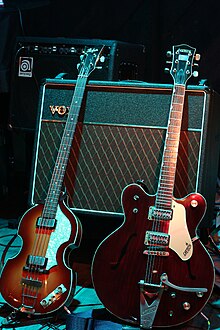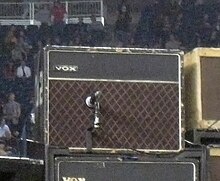Vox AC30: Difference between revisions
→History: "The Edge's AC30" is misleading, as the picture is not of his famous original 1964 AC30 that has been used to record every U2 album. This is my picture of his1964 AC30 . |
|||
| Line 8: | Line 8: | ||
By 1960, Vox had forsaken the more conservative TV-front look for the now legendary cabinet design that has remained largely unchanged since 1960. The new cabinets featured a different covering known as fawn Rexine, which was a sort of beige leathercloth with a subtle printed grain. The front baffle was now divided by a thin gold-toned strip with the upper valence covered in fawn Rexine, and the lower grill covered in brown diamond cloth. Ventilation was provided by three small brass vents on the top of the cabinet, and the TV-front's single suitcase type handle was replaced with three leather straps. |
By 1960, Vox had forsaken the more conservative TV-front look for the now legendary cabinet design that has remained largely unchanged since 1960. The new cabinets featured a different covering known as fawn Rexine, which was a sort of beige leathercloth with a subtle printed grain. The front baffle was now divided by a thin gold-toned strip with the upper valence covered in fawn Rexine, and the lower grill covered in brown diamond cloth. Ventilation was provided by three small brass vents on the top of the cabinet, and the TV-front's single suitcase type handle was replaced with three leather straps. |
||
[[Image:EdgeAC30.jpg|thumb|Edge's original 1964 [[Vox AC30]] on stage |
[[Image:EdgeAC30.jpg|thumb|Edge's original 1964 [[Vox AC30]] on stage. This AC30 has been used to record every U2 album ]] |
||
To cure the unreliability issues Vox introduced another version of AC30 in 1961 that substituted the EF86 with ECC83's (a.k.a. 12AX7's). Its circuit had three channels, each with two inputs, and was therefore named AC30/6. The amplifiers also came with three different “voicing” alternatives (Normal, Brilliant, and Bass) that were accomplished by slight circuit modifications. |
To cure the unreliability issues Vox introduced another version of AC30 in 1961 that substituted the EF86 with ECC83's (a.k.a. 12AX7's). Its circuit had three channels, each with two inputs, and was therefore named AC30/6. The amplifiers also came with three different “voicing” alternatives (Normal, Brilliant, and Bass) that were accomplished by slight circuit modifications. |
||
Revision as of 02:53, 21 November 2009

The Vox AC30 is a guitar amplifier manufactured by Vox and known for its "jangly" high-end sound.
History
The Vox AC30 was originally introduced in 1958 as “big brother” for the fifteen watt AC15 model, Vox's original flagship amplifier. The AC15 was powered by a pair of EL84 tubes, an EF86-driven Normal channel and ECC83-driven Vib-Trem channel, and rectified by an EZ81. The Original AC30, or AC30/4, had only a single 12 inch Goodman 60 watt speaker as opposed to the later, conventional twin 12” speaker configuration. AC30/4 sported two channels with two inputs – hence the “4” in the model name. There was only a single tone control in it as well. The power amplifier circuit had EL34 tubes and the preamplifier used an EF86, which was a pretty unreliable tube and could fail due to vibration. The amplifier had a tube rectifier.
This first generation of AC30's were housed in "TV-front" cabinets, much like the early to mid 50's tweed Fender amps. However, the Voxes sported a thin white covering (Rexine) with a small printed diamond pattern and larger diamond pattern grill cloth. The EL34 powered AC30 was short lived, and was soon powered by a quartet of EL84 (6BQ5) power tubes, making it truly a doubling of the AC15. Vox initially offered a 1X12" version and subsequently introduced the 2X12" AC30 Twin, which solved the volume problem at larger venues. The original TV-front AC30's are extremely rare. The first AC30 Twins used Goodmans Audiom 60's 15 Watt Speakers, followed by Celestion G12 alnico speakers, although not yet sporting the handsome blue paintjob.
By 1960, Vox had forsaken the more conservative TV-front look for the now legendary cabinet design that has remained largely unchanged since 1960. The new cabinets featured a different covering known as fawn Rexine, which was a sort of beige leathercloth with a subtle printed grain. The front baffle was now divided by a thin gold-toned strip with the upper valence covered in fawn Rexine, and the lower grill covered in brown diamond cloth. Ventilation was provided by three small brass vents on the top of the cabinet, and the TV-front's single suitcase type handle was replaced with three leather straps.

To cure the unreliability issues Vox introduced another version of AC30 in 1961 that substituted the EF86 with ECC83's (a.k.a. 12AX7's). Its circuit had three channels, each with two inputs, and was therefore named AC30/6. The amplifiers also came with three different “voicing” alternatives (Normal, Brilliant, and Bass) that were accomplished by slight circuit modifications.
As musicians' demand for features continued to grow, Vox also introduced something that would become known as “Top Boost” modification. The "Top Boost" or "Brilliance", as it was originally called, was an addition of a rear panel-mounted unit that introduced an extra gain stage and tone controls for bass and treble (as opposed to single "tone" control of early AC30s). The unit became so popular that its features were soon implemented to newer AC30/6 models and the controls moved from rear panel to the control panel. Vox AC30/6 amplifiers from around 1963 had already “implemented” the top boost, and therefore had 3 tone controls. People began to refer to these amplifiers as AC30TBs.[1]. Around the same time, Vox also introduced Treble and Bass versions of the AC30 without the Top Boost unit. Instead, the circuits of the Treble and Bass versions were slightly modified to emphasize those frequencies.
In late 60’s Jennings drifted into financial problems and the company experienced various owner changes. Quality control was also inconsistent.
During Vox' early '70s "Dallas Arbiter" period, the tube rectifiers of AC30s were replaced by silicon rectifiers. This became a standard for later AC30TB models. In the late 1970’s Vox also introduced a solid-state AC30 (AC30SS), which was quite successful. For example, this is the AC30 model that was used by Status Quo. A tube AC30TB with spring reverb feature was reintroduced in 1978.
In spite of at least one AC30 production run titled “Limited Edition” (1991), production of the AC30 has practically never ceased: Newer AC30s are reissues of the various top boost AC30/6 (AC30TB) models. AC30s made between 1989 and 1993 also had spring reverb as a standard feature.
The Rose Morris company, who owned the Vox name through the 1980s, sold Vox to Korg in the early 1990s, who then manufactured a superb reissue of the early '60s AC30 Top Boost, correcting previous inconsistencies from the correct style grille cloth to the GZ34 rectifier tube. These AC30 amps were mostly offered in the traditional black Tolex/brown diamond grille configuration, but were also available in limited numbers with purple, red, or tan tolex. These amplifiers, like all AC30s to this point, were manufactured in Great Britain. These were available with a choice of Celestion "Blue" or Greenback speakers.
AC30 Custom Classic Series
In 2004, Vox introduced a new series of amplifier called the AC30 Custom Classic. It claims to combine attributes of the original AC30 with what Vox sales literature refers to as a "boutique" of features. Specifications of the AC30CC series are two Inputs (Top Boost & Normal) an Input Link Switch for blending channels, a Normal Volume knob, a Brilliance Switch, a Top Boost Volume knob, a Treble knob, a EQ Standard/Custom Switch, Bass and Reverb Controls (Tone, Mix, and a Dwell Switch), Tremolo Speed & Depth knobs, a Tone Cut knob, a Master Volume knob, a Standby and a Power Switch, switchable cathode bias (low-power switch: 33W at full power, 22W at low power), switchable filter values (vintage/modern) and a true bypass effects loop. Newer AC30CC (or “Custom Classic”) reissues (CC1, CC2X CCH head) are produced in China. All AC30CC series amps, although believed to be 30watts, are in fact 40 watts in power handling.
AC30BM
Recently, Vox released a limited edition version of the amp, the AC30BM, based on the tone of one of the amp's most prominent and consistent endorsers, Brian May of Queen. The amp is limited to only a few hundred examples worldwide, in a 'never-to-be-repeated' run. As the amp is designed to replicate May's tone, there are no controls on the amp except for a single volume control, though a switch enables the user to halve the number of output valves (therefore reducing the output to 15 watts as well as the volume, making it more suitable for home use), and there is a boost function operated from the included footswitch.
JMI returns
As of 2006, a company having licensed the name JMI (Jennings Musical Instruments) began manufacturing period correct, British made AC30 "copy" amplifiers, available in both black and beige. Since this incarnation of JMI has never owned the Vox brand, their official website lists the disclaimer "JMI amplification are in no way affiliated with Vox amplification (Korg)", and the models are listed as 30/6 (6 input) and 30/4 (4 inputs, sans "Brilliant" channel). As originally the case in the 1960s, Top Boost is offered as a retrofit upgrade and is not standard, and the original configuration 4/6 inputs are offered, with options for Green/Blue speakers, the blue speakers being similar in appearance to the Celestion alnico speaker but made by Fane with fiberglass voice coils which allow them a much higher 100 watt power rating.
Electronics
An AC-30 is a 30-watt tube (valve) guitar amplifier. Though widely believed to be a Class-A amplifier, it is in fact a class AB1 amp with cathode bias[2] [3] [4]. It utilizes a quartet of EL-84 output tubes. The high bias condition is believed by some to be the source of the amplifier's famous immediate response and "jangly" high-end, though the lack of negative feedback, minimal preamp circuit, simple low loss tone stack, and the use of cathode biasing on the output stage play at least as large a role, if not larger. Its Celestion "Blue" speakers are integral to the AC-30, and also contribute much to the sound of the unit. The two 12" 15-watt speakers, often overdriven and at the brink of their power handling capability provide a cutting mid-range speaker sound that is immediate and sharp, distinct from the Marshall or Fender-style amplifier.
Notable users of the AC30
- Hank Marvin, Bruce Welch and Jet Harris of The Shadows, for whom the amplifier was developed
- John Lennon, Paul McCartney and George Harrison of The Beatles
- Keith Richards and Brian Jones of The Rolling Stones
- Pete Townshend of The Who
- Paul Weller of The Jam
- Rory Gallagher
- John Scofield, noted jazz/fusion guitarist
- Brian May of Queen
- Snowy White
- The Edge and Bono of U2
- Tom Petty and Mike Campbell of Tom Petty and the Heartbreakers
- Peter Buck of R.E.M.
- Justin Hayward of the Moody Blues
- Jonny Greenwood of Radiohead
References
- ^ Glen Lambert. "Vox AC30 Topboost - Reasons & Origins A?".
- ^ Randall Aiken. "Is the Vox AC-30 Really Class A?". Aiken Amps technical pages.
- ^ Randy Jamz. "Vox AC30 Myths". Tales from the Tone Lounge.
- ^ Mark Breecher & Shane Dolman. "Class Distinction". Sheldon Amps Website.
